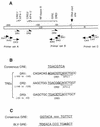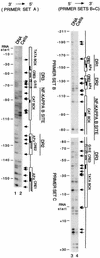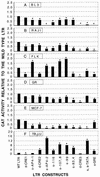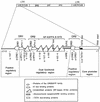In vivo protein binding and functional analysis of cis-acting elements in the U3 region of the bovine leukemia virus long terminal repeat
- PMID: 9621062
- PMCID: PMC110404
- DOI: 10.1128/JVI.72.7.5994-6003.1998
In vivo protein binding and functional analysis of cis-acting elements in the U3 region of the bovine leukemia virus long terminal repeat
Abstract
Bovine leukemia virus (BLV) is a member of the human T-cell leukemia virus (HTLV)/BLV group of retroviruses. These viruses regulate their own transcription by producing Tax, a protein which activates the virus promoter region, the long terminal repeat (LTR). To explore the molecular mechanisms involved in the transactivation, we identified protein binding elements by in vivo footprinting and analyzed their function by site- directed mutagenesis. We used in vivo dimethyl sulfate footprinting by ligation-mediated PCR to detect constitutive in vivo protein-DNA interactions in a BLV-producing cell line, Bat2Cl6. The U3 region and part of the R region of the LTR were footprinted. In addition to the cis-acting elements (three cyclic AMP-responsive elements [CREs] and two AP4 sites) reported by others to be important for Tax-mediated activation of the BLV LTR, we found footprints in regions flanking these elements and in the core promoter region. The importance of these sites for transcriptional activation was studied by site-directed mutagenesis followed by promoter function analysis of the mutants with a chloramphenicol acetyltransferase reporter system. Our data corroborate those of others showing that the CREs are necessary for transactivation of the LTR, and they identify two new functional sites not previously reported by others. We show that the middle region of the BLV U3 contains multiple dual-functioning cis-acting elements which act as either positive or negative regulatory elements depending on the cell type tested. This is the first report of a functional mapping of the cis-acting elements of a virus of the HTLV/BLV group.
Figures






Similar articles
-
The region between amino acids 245 and 265 of the bovine leukemia virus (BLV) tax protein restricts transactivation not only via the BLV enhancer but also via other retrovirus enhancers.J Virol. 2000 Dec;74(23):10939-49. doi: 10.1128/jvi.74.23.10939-10949.2000. J Virol. 2000. PMID: 11069988 Free PMC article.
-
Regulation of Expression and Latency in BLV and HTLV.Viruses. 2020 Sep 25;12(10):1079. doi: 10.3390/v12101079. Viruses. 2020. PMID: 32992917 Free PMC article. Review.
-
A sensitive luminescence syncytium induction assay (LuSIA) based on a reporter plasmid containing a mutation in the glucocorticoid response element in the long terminal repeat U3 region of bovine leukemia virus.Virol J. 2019 May 20;16(1):66. doi: 10.1186/s12985-019-1172-2. Virol J. 2019. PMID: 31109347 Free PMC article.
-
Upstream stimulatory factors binding to an E box motif in the R region of the bovine leukemia virus long terminal repeat stimulates viral gene expression.J Biol Chem. 2002 Mar 15;277(11):8775-89. doi: 10.1074/jbc.M107441200. Epub 2001 Dec 10. J Biol Chem. 2002. PMID: 11741930
-
Internal transcriptional regulatory elements in HIV-1 and other retroviruses.Cell Mol Biol (Noisy-le-grand). 1995 May;41(3):365-9. Cell Mol Biol (Noisy-le-grand). 1995. PMID: 7580829 Review.
Cited by
-
The region between amino acids 245 and 265 of the bovine leukemia virus (BLV) tax protein restricts transactivation not only via the BLV enhancer but also via other retrovirus enhancers.J Virol. 2000 Dec;74(23):10939-49. doi: 10.1128/jvi.74.23.10939-10949.2000. J Virol. 2000. PMID: 11069988 Free PMC article.
-
Bovine leukemia virus long terminal repeat variability: identification of single nucleotide polymorphisms in regulatory sequences.Virol J. 2018 Oct 25;15(1):165. doi: 10.1186/s12985-018-1062-z. Virol J. 2018. PMID: 30359262 Free PMC article.
-
Defibrinated bovine plasma inhibits retroviral transcription by blocking p52 activation of the NFkappaB element in the long terminal repeat.Can J Vet Res. 2007 Apr;71(2):119-28. Can J Vet Res. 2007. PMID: 17479775 Free PMC article.
-
Regulation of Expression and Latency in BLV and HTLV.Viruses. 2020 Sep 25;12(10):1079. doi: 10.3390/v12101079. Viruses. 2020. PMID: 32992917 Free PMC article. Review.
-
Effects of Naturally Occurring Mutations in Bovine Leukemia Virus 5'-LTR and Tax Gene on Viral Transcriptional Activity.Pathogens. 2020 Oct 13;9(10):836. doi: 10.3390/pathogens9100836. Pathogens. 2020. PMID: 33066207 Free PMC article.
References
-
- Allen L J, Kabbur M B, Cullor J S, Gardner I A, Stott J L, George L W. Alterations in blood lymphocyte subpopulations and hematologic values in neonatal calves after administration of a combination of multiple-antigen vaccines. J Am Vet Med Assoc. 1996;209:638–642. - PubMed
-
- Baliga V, Ferrer J. Expression of the bovine leukemia virus and its internal antigen in blood lymphocytes. Proc Soc Exp Biol Med. 1977;156:388. - PubMed
-
- Boros I M, Tie F, Giam C Z. Interaction of bovine leukemia virus transactivator Tax with bZip proteins. Virology. 1995;214:207–214. - PubMed
Publication types
MeSH terms
Substances
LinkOut - more resources
Full Text Sources

